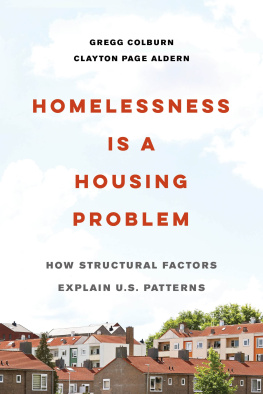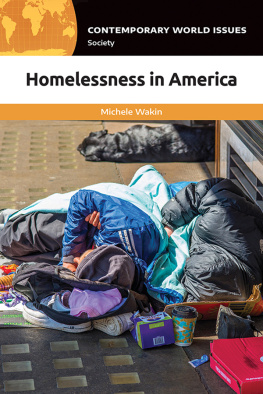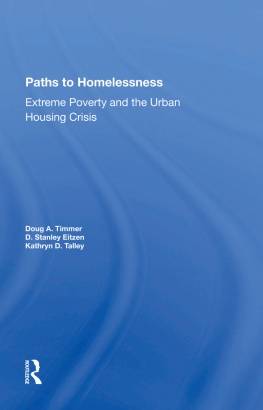First published 2000 by Garland Publishing, Inc.
Published 2020 by Routledge
2 Park Square, Milton Park, Abingdon, Oxon OX14 4RN
605 Third Avenue, New York, NY 10017
Routledge is an imprint of the Taylor & Francis Group, an informa business
Copyright 2000 by Karleen Jackson
All rights reserved. No part of this book may be reprinted or reproduced or utilised in any form or by any electronic, mechanical, or other means, now known or hereafter invented, including photocopying and recording, or in any information storage or retrieval system, without permission in writing from the publishers.
Notice:
Product or corporate names may be trademarks or registered trademarks, and are used only for identification and explanation without intent to infringe.
Library of Congress Cataloging-in-Publication Data is available from the Library of Congress.
ISBN 13: 978-0-8153-3581-8 (hbk)
This work is dedicated to all those who share the vision of a world where everyone has a place to call home, where everyone is welcome and loved, and where we understand that all our words and actions impact others for good or evil.
In the early 1990s family homelessness skyrocketed in Anchorage, Alaskaso much so that the Governor allocated emergency funding for a temporary shelter to operate from January through May of 1992 to ensure the health and safety of homeless children and their parents. When the opportunity arose for me to do my practicum work for a bachelors degree in psychology at the Family Shelter, I had no idea the experience would have a life-altering effect on me. I expected to learn more about the psychological problems faced by those who were homeless, but I didnt expect to find my worldview forever changed by those experiencing homelessness.
My initial encounters with homeless families shattered my illusions about the causes and consequences of homelessness. It took less than one 8 hour shift at the Family Shelter for me to grasp the complexity of this issue and discard the notion that homelessness had a simple solution. I also came to realize that home is not just a physical structure, but a web of interpersonal relationships. As Ray Bolger described it in Fricke, Scarfone, and Stillman (1989, p. 242): a home isnt just a place or an abodeits people, people you love and who love you.
Trying to help an assortment of diverse people find their way home through a maze of challenging barriers, I grew to appreciate the unique and invincible strengths possessed by each person with whom I interacted. I was awed by the courage exhibited by those experiencing the disempowering situations which led to homelessness. They embodied what Rollo May (1975) called social courage, and defined as:
The courage to relate to other human beings, the capacity to risk ones self in the hope of achieving meaningful intimacy. It is the courage to invest ones self over a period of time in a relationship that will demand an increasing openness. Intimacy requires courage because risk is inescapable. We cannot know at the outset how the relationship will affect us. Like a chemical mixture, if one of us is changed, both of us will be. (p. )
Unfortunately, the two common challenges faced by the homeless families who resided at the Family Shelter were their lack of a physical housing structure and their limited or non-existent web of loving, supportive relationships. As a result, I began to wonder if research might confirm that strong support networks facilitated the transition from homelessness to permanent independent living. Therefore, my undergraduate research project in the spring of 1992 was a study called Is There a Correlation Between the Resiliency of Parents and Their Ability to Extricate Their Families from the Crisis of Homelessness? That study identified five aspects of social support (extended family members; authorities such as employers; intergenerational groups; counselors and social service personnel; and peers) as major factors contributing to resiliency. In addition, the results showed a significant correlation ( p =.562, N =100) between supportive relationships and the ability of families to exit homelessness.
As a result of my work at the Family Shelter and my 1992 research on resiliency and homelessness, I was hired by Catholic Social Services to develop a program for homeless families. This project was initially funded by a federal SAFAH (Supplemental Assistance and Facilities to Assist the Homeless) grant from the Department of Housing and Urban Development (HUD) which was administered by the Alaska Housing Finance Corporation (AHFC). The Beyond Shelter Program combined long-term supportive case management services; monthly client support groups; financial assistance to secure housing, child care and education for increased employability; and referrals to other resources which could provide adequate social support to assist families in obtaining and maintaining housing.
The Beyond Shelter Program represented a new approach to homelessness in Alaska, and was cited in the Comprehensive Housing Affordability Strategy for the State of Alaska (Barker, 1994) as a model supportive services program for homeless families. It was my privilege to serve as the primary case manager working directly with clients in the Beyond Shelter Program (BSP) for the first 14 months of operation. At that time a second case manager joined the program, so that I could also assume the responsibilities of program director. By the end of the third year of operations, the BSP had enrolled 102 homeless families, with 96 of those families successfully moving to permanent housing, and only one family returning to homelessness.
In part, as a result of the success achieved by families in the Beyond Shelter Program, another 3 year HUD Supportive Housing grant (first called Reach For Independence and later the LINK Project) was awarded to the Municipality of Anchorage in 1995 which allowed Catholic Social Services to expand the BSP in 1996 to include services to homeless individuals as well as families. It also enabled the AWAIC (Abused Womens Aid In Crisis) shelter to replicate the BSP for homeless victims of domestic violence. In addition, the SAFAH grant administrator, Alaska Housing Finance Corporation (AHFC) applied to HUD and was awarded a 2 year extension of the original SAFAH grant, allowing the Beyond Shelter Program to serve additional families through 1998.
AHFC also arranged for the University of Alaska Center for Human Development to perform a research study to provide an external evaluation of how effectively the supportive services offered by the BSP facilitated families exiting homelessness (Knox & Mercer, 1996). The data available in that evaluation plus my own experience as the developer, initial case manager, and subsequent director of the Beyond Shelter Program stimulated my interest in further studying the supports and barriers that homeless families encounter as they work to achieve permanent independent housing.








